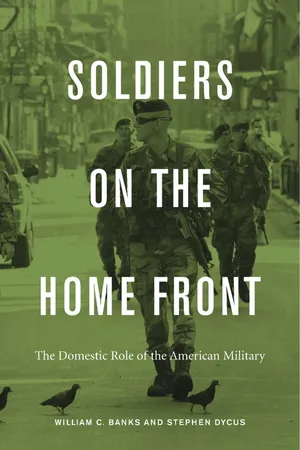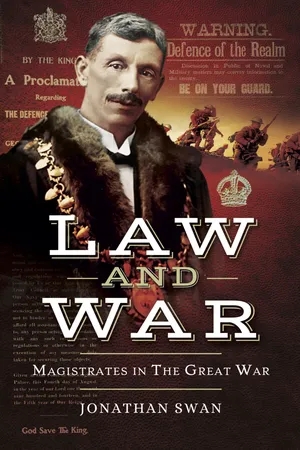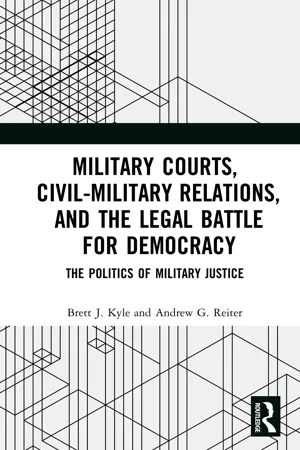Law
Martial Law
Martial law is a temporary imposition of military authority over a designated region, often in response to a crisis or emergency. It grants the military greater powers to maintain order and security, including the ability to enforce laws and restrict civil liberties. Martial law is typically declared by a government in times of extreme unrest or threat to public safety.
Written by Perlego with AI-assistance
4 Key excerpts on "Martial Law"
Learn about this page
Index pages curate the most relevant extracts from our library of academic textbooks. They’ve been created using an in-house natural language model (NLM), each adding context and meaning to key research topics.
- eBook - ePub
- William C. Banks, Stephen Dycus(Authors)
- 2016(Publication Date)
- Harvard University Press(Publisher)
Fortunately, the United States, unlike many nations, has actually experienced Martial Law only rarely, and even then only on a limited basis. Yet it is not hard to imagine scenarios in which the ability of civilian government to function normally might be seriously tested. A pandemic of some contagious disease, manmade or otherwise, or a cyber attack that shut down a regional electric grid for an extended period are among the most likely. Martial Law is the predictable response to such a worst-case scenario, because only troops might be thought capable of maintaining some semblance of order.But Martial Law also is a worst-case scenario. It is the product of a failure of planning—when conditions allow the use of force to replace the rule of law. The result may be utterly unpredictable and even unprincipled. Government is conducted ad hoc by a military commander based entirely upon his or her opinion of what is needed to meet the emergency, with no transparency or public participation, and perhaps no accountability afterward.By “Martial Law” we mean here the displacement of ordinary domestic civilian government by military forces. We do not mean “military law,” which refers to rules for the behavior of military personnel (for example, the Uniform Code of Military Justice), or “military government,” which applies to the military’s occupation of conquered territory.4This chapter is about our experience with Martial Law—circumstances for its proclamation, and consequences of its implementation. It also is, more importantly, about how to avoid Martial Law in the future.5BLACKSTONE’S “NO LAW”
Early in the seventeenth century, in the midst of the Thirty Years War, Charles I quartered troops in homes along England’s southern coast and declared Martial Law to quell civilian protests. Parliament reacted by adopting the Petition of Right in 1628, which included a prayer that “Martiall Lawe” not be used to punish subjects.6 The great English jurist Sir Edward Coke, principal author of the petition, asserted that Magna Carta and earlier parliamentary acts, which guaranteed due process for subjects accused of crimes, also impliedly forbade Martial Law in peacetime, when “courts of justice be open, and the judges and ministers of the same may by law protect men from wrong and violence, and distribute justice to all.”7 - eBook - ePub
- Carl Schmitt(Author)
- 2015(Publication Date)
- Polity(Publisher)
It is for this entire sphere of real military activity – which is, in consequence, to be categorically separated from court martial [ militärisches Standrecht, martial jurisdiction] – that ‘Martial Law’ comes into effect. It is a kind of situation outside the law, in which the executive – that is, the intervening army – can act without paying heed to any legal limitations, doing whatever it takes to suppress the enemy in the given circumstances. Despite its name, Martial Law [ Kriegsrecht ], understood in this way, is not a right or a law at all, but rather a procedure, which is genuinely governed by a practical goal and in which the legal control limits itself to the conditions under which that procedure has come into effect (commandeering of civil bodies, requests of dismissal, and so on). As legal justification [ Rechtsgrund ] for what happens in situations that fall outside the law, it has been argued that in such cases all the state powers become impotent and without effect and, in particular, the courts cannot function any more. Then the only functioning power of the of state, the army, should become active as a kind of substitute (some rude substitute), and its action should represent both the verdict and the execution, all wrapped up in one. 4 It has been increasingly vital for the Anglo-Saxon sense of justice that, in times of war and upheaval, the army functioned as a substitute for the courts, and therefore Martial Law presupposed a kind of iustitium [cessation of public activity]. This also happened for example in the American law of 1795, which, according to Garner, 5 is still in effect and which gave the presidents of the United States permission to call in the militia in the event of a hostile invasion, or when the law was disregarded or its execution was so seriously jeopardised that the unlawfulness could not be quelled through normal jurisdiction and executive forces - eBook - ePub
Law and War
Magistrates in the Great War
- Jonathan Swan(Author)
- 2017(Publication Date)
- Pen and Sword(Publisher)
At the end of the hour the militia, or local military forces, could and were sent to clear the mob from the streets, and section 3 of the Act indemnified them from any death or injuries caused. Any individuals apprehended were tried in the civil courts, and usually for specific offences such as assault, affray or criminal damage. These powers were sufficient to deal with the Gordon Riots of 1780, the Peterloo Massacre of 1819, and many popular uprisings, protests and strikes up to the period of the First World War. Even with the Jacobite Rising of 1745 and the march of the Scottish forces as far south as Derby it was not felt necessary to impose any new law to deal with this ‘invasion’ or to view this as anything other than a temporary or local rebellion. The test applied by the legal authorities was that the courts were able to function normally; in the absence of widespread or long term disorder, from whatever cause, there was no requirement for special legislation.The concept of Martial Law was not well explored, legally or practically. Blackstone and Hale, above, did not distinguish a difference between ‘martial’ and ‘military’ law, and the ‘indulgence’ was that for both of them, and many other legal thinkers, it was absurd to consider how military law might be applied to a civilian population. Dicey, in his influentialLaw of the Constitution 8proposed that ‘Martial Law … is unknown in England’, and he defined Martial Law as ‘the suspension of ordinary law and the temporary government of the country or parts of it, by military tribunals’. Even with the growth of Empire the problem of ‘Martial Law’ was not fully considered. If the army was on offensive operations in foreign or enemy territory, it was governed by the Mutiny Act and the Articles of War. If on peaceable duties in Crown colonies, civil law, modelled of course on English legal institutions, prevailed. With the exportation of Anglo-Saxon common law principles, the governors of overseas territories had a common law duty to preserve the peace, supported by the local Riot Act, and often by a Royal warrant or article of appointment granting them general powers of control in an emergency. There were several cases when such powers were exercised: Canada (1838), Barbados (1816), and Jamaica (1865) which resulted in judicial review in the British High Courts. In all such instances, however, the threat was from the ‘enemy within’, in the form of rebellion of His Majesty’s subjects, rather than from a hostile enemy from without. The notable feature of colonial legal system was the general lack of an efficient and disciplined police force, and such as did exist were likely to be easily overwhelmed by the mob. The imposition of Martial Law provided the governor with the necessary force to control the civil disorder and restore peace. Whether at home or overseas Riot Act offences were dealt with by the civil courts. Any invocation of the Act was invariably followed by a Parliamentary Act of Indemnity. - eBook - ePub
Military Courts, Civil-Military Relations, and the Legal Battle for Democracy
The Politics of Military Justice
- Brett J. Kyle, Andrew G. Reiter(Authors)
- 2020(Publication Date)
- Routledge(Publisher)
11 Many codes of military justice allow for some types of civilians to be tried in military courts, such as those employed directly by the military. In addition, in situations in which civilians and members of the military are involved in a large conspiracy together, some codes allow for the case to be consolidated in military courts. In most countries, military courts rarely, if ever, try civilians under those criteria. If a country abuses the law and applies military justice to civilians more broadly, we classify it as military overreach.12 Sanción Ley 14.029, “Código de Justicia Militar,” 4 de julio de 1951, http://servicios.infoleg.gob.ar/infolegInternet/anexos/105000-109999/105438/texact.htm .13 Terminology varies considerably across countries (Gross and Ní Aoláin 2006 , 40–46). When discussing a specific case, we use the term used in that country.14 For the most comprehensive overview of the concept of Martial Law and the origins of its practice, see Birkhimer 1914 .15 For an overview of emergency powers, see Ferejohn and Pasquino 2004 .16 This is often referred to as the debate over “reasons of state.”17 The extra-legality model agrees that democracies need flexibility to meet crises but argues that provisions for the suspension of rights should not be built into the constitution. Rather, elected leaders should “break the law” when faced with threats, with the public ratifying or rejecting the decisions ex post (Gross 2003 ; Gross and Ní Aoláin 2006 , 110–70).18 Constitution of the German Empire of August 11, 1919 (Weimar Constitution), http://ghdi.ghi-dc.org/sub_document.cfm?document_id=3937 . Karl Lowenstein (1937) argued that Germany and other European democracies should have used these provisions themselves first to crack down on anti-democratic groups to prevent them from rising to power.19 For a detailed critique of the ratchet and fear/panic arguments, see E. Posner and Vermeule 2003 .20 Law to Remove the Distress of the People and the Reich (The Enabling Act), March 24, 1933, http://ghdi.ghi-dc.org/sub_document.cfm?document_id=1496 .- 21



